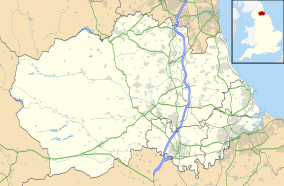Bishop Middleham Quarry facts for kids
Quick facts for kids Bishop Middleham Quarry |
|
|---|---|

Disused quarry at Bishop Middleham
|
|
| Location | County Durham, North East, England |
| Area | 8.6 ha (21 acres) |
| Established | 1968 / 1982 |
| Governing body | Durham Wildlife Trust |
| Website | Map of site |
Bishop Middleham Quarry is a really interesting place in County Durham, England. It's an old quarry, which means people used to dig out rocks from here. This quarry is about 4 kilometers (2.5 miles) north-west of a town called Sedgefield.
Digging stopped in 1934. Since then, nature has taken over! The ground here is made of a special rock called Magnesian Limestone. This rock has made the area perfect for many unique plants and animals to live.
Contents
Bishop Middleham Quarry: A Special Natural Spot
This quarry was officially made a "biological Site of Special Scientific Interest" (SSSI) in 1968. This means it's a very important place for wildlife and nature. Later, in 1982, the boundaries were changed a bit. This was to make sure only the areas with the most important wildlife were protected.
What Makes This Quarry Special?
Bishop Middleham Quarry has many different types of plants. You can find woodlands, bushy areas (called scrub), and different kinds of grasslands. The most important part for nature is a special type of grassland. It's called "species-rich unimproved magnesian limestone grassland."
This special grassland covers almost 4.6 hectares (about 11 acres) of the site. That might not sound like much, but this type of habitat is very rare in Britain. There are only about 270 hectares of it in the whole country! A big part of it, about two-thirds, is right here in County Durham.
Amazing Plants and Animals
The magnesian limestone grassland is home to special plants called calcicolous plants. These plants love to grow in thin soil on limestone. They are adapted to live in places where the grass doesn't grow too tall.
One of the most exciting plants here is the dark red helleborine. It's a nationally rare species of orchid. In 2010, a survey found almost 1,700 flowering plants of this rare species! That's one of the biggest groups in Britain.
The quarry is also a home for a special butterfly called the Durham argus. This butterfly is a local type of the brown argus butterfly. You can only find this particular kind in northeast England.
Birdwatchers also got excited about the quarry in 2002. A pair of European bee-eaters decided to live there and even raised two young birds. This was only the third time bee-eaters had ever tried to breed in Britain!
Looking After the Quarry
Bishop Middleham Quarry is looked after as a Nature Reserve by the Durham Wildlife Trust. They work hard to protect the plants and animals that live there.
In June 2009, an organization called Natural England checked on the site. They gave it a "favourable" rating. This means the quarry is in good condition and the wildlife is doing well.



